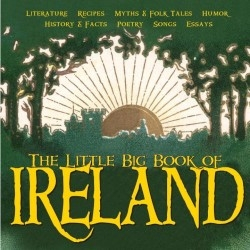The Little Big Book of Ireland
“Where the fields are sharply green, where a wild beauty hides in the glens … for the first time I see the face of the Irish countryside.” — H. V. Morton
That small island in the Atlantic Ocean exerts a strong pull on the heart and soul of anyone who’s ever set foot on her soil, and on the dreams and longings of many who haven’t. Those memories and yearnings will find fulfillment in this book, the latest installment in Welcome’s Little Big Book series (previous volumes focus on topics such as grandparents, laughter, baseball, and Christmas).
The editors have compiled a treasury of Irish-themed art and writing—from songs, folk tales, and recipes, to “Facts and Fancy,” to classic literature. (Measom, who is of Irish descent, is a travel writer whose other projects include The Art of X-Men and The Da Vinci Code Illustrated Screenplay. Wakabayashi is also part Irish and has written, designed, and edited many books, including two previous Little Big Books as well as Wish You Were Here in the Wild.
They have gathered excerpts from the likes of playwright John Millington Synge, poet William Butler Yeats, and novelist James Joyce. A selection from Joyce’s A Little Cloud describes the poetry of the Irish spirit. His main character, Little Chandler, “tried to weigh his soul to see if it was a poet’s soul. Melancholy was the dominant note of his temperament, he thought, but it was a melancholy tempered by recurrences of faith and resignation and simple joy.”
Such simple joy is evident in whimsical lists, like an assortment of Irish blessings (“May you escape the gallows, avoid distress, and be as healthy as a trout”) and curses (“May the only tears at your graveside be the onion pullers’!”). Other “Facts and Fancy” pages offer inventories like “Great Irish Americans” (including ten presidents, Georgia O’Keeffe, and John Wayne), and recent “Fillims” that take place in Ireland.
Irish melancholy is epitomized by Seamus Heaney’s poem, “Digging.” The poet pays homage to his father’s efforts digging potatoes and his grandfather’s toil digging turf for fuel, then concludes: “I’ve no spade to follow men like them. // Between my finger and my thumb / the squat pen rests. / I’ll dig with it.” On a more impish note, William Allingham’s “The Fairies” describes in rhyme the antics of leprechauns: “Wee folk, good folk / Trooping all together; / Green jacket, red cap / and white owl’s feather!”
The illustrations are soft, charming, and fanciful, many taken from turn-of-the-last-century postcards. Bearded gnome-like men with clay pipes abound, as do peaceful verdant landscapes, stylized shamrocks, and fresh-faced lasses.
The Irish are the world’s greatest storytellers, and this collection relates more than a dozen classic tales, such as “The Legend of Finn MacCumhal” and “The Sea Fairies.” Several (like “The Banshee” and “The Changeling”) are told by Lady Francesca Speranza Wilde (Oscar’s mother), from her 1887 book of Irish folklore. “Sometimes,” writes Lady Wilde, “the Banshee assumes the form of some sweet singing virgin who died young, and has […] become the harbinger of coming doom to her mortal kindred.”
These sweet and sorrowful selections are interspersed with recipes for dishes like “Crubeens” (Pig’s Trotters) and “Aunt Joan’s Colcannon,” made of mashed potatoes and cabbage. Lyrics to songs are included, from the standards “Danny Boy” and “Wearing of the Green” to less well-known ditties like “Ireland’s Thirty-Two,” which names all of Ireland’s counties, including those seized by England. The song’s chorus rallies: “Here’s to old Ireland undivided / To all good Irishmen and true.”
“The Troubles” are mentioned only briefly, in the editors’ compressed “Wee Bit o’ History,” and a page on “Bloody Sunday,” January 30, 1972, when an Irish civil rights demonstration in Derry resulted in the deaths of unarmed protesters, including children, at the hands of the English Army. An Gorta Mor (the Great Hunger, or Famine) is described succinctly and without rancor towards England, which will leave optimistic readers relieved and political readers antagonized.
Biographical information about the authors and illustrators would have elevated this book to a significant cultural contribution. As it is, The Little Big Book of Ireland is a merry celebration of the grit, spirit, and talent of a people who have for centuries lived a life both enchanted and arduous on a rocky, wind-swept emerald jewel in the ocean.
Disclosure: This article is not an endorsement, but a review. The publisher of this book provided free copies of the book to have their book reviewed by a professional reviewer. No fee was paid by the publisher for this review. Foreword Reviews only recommends books that we love. Foreword Magazine, Inc. is disclosing this in accordance with the Federal Trade Commission’s 16 CFR, Part 255.

